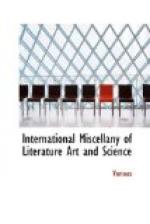11, 1781. He was educated for the Church of Scotland,
of which he became a licentiate; and in 1800 he received
the honorary degree of M. A. from the University of
Edinburgh. While studying here he enjoyed the
friendship of Robison, who then filled the Chair of
Natural Philosophy; Playfair, of Mathematics; and
Dugald Stewart that of Moral Philosophy. In 1808,
he undertook the editorship of the “Edinburgh
Encyclopaedia,” which was only finished in 1830.
In 1807 he received the honorary degree of LL.
D. from the University of Aberdeen; and in 1808 was
elected a Fellow of the Royal Society of Edinburgh.
Between 1801 and 1812 he devoted his attention greatly
to the study of Optics; and the results were published
in a “Treatise on New Philosophical Instruments,”
in 1813. In 1815 he received the Copley Medal
of the Royal Society for one of his discoveries in
optical science; and soon after was admitted a Fellow
of that body. In 1816, the Institute of France
adjudged to him half of the physical prize of 3000
francs, awarded for two of the most important discoveries
made in Europe, in any branch of science, during the
two preceding years; and in 1819, Dr. Brewster received
from the Royal Society the Rumford gold and silver
medals, for his discoveries on the Polarization of
Light. In 1816 he invented the Kaleidoscope,
the patent-right of which was evaded, so that the
inventor gained little beyond fame, though the large
sale of the instrument must have produced considerable
profit. In 1819, in conjunction with Dr. Jameson,
he established the “
Edinburgh Philosophical
Journal”; and subsequently he commenced the
“
Edinburgh Journal of Science,”
of which sixteen volumes appeared. In 1825, the
Institute of France elected him a Corresponding Member;
and he has received the same honor from the Royal
Academies of Russia, Prussia, Sweden, and Denmark.
In 1831, he received the Decoration of the Hanoverian
Guelphic Order; and in the following year, the honor
of Knighthood from William the Fourth.
Sir David Brewster has edited and written various
works, besides contributing largely to the Edinburgh
Review, the Transactions of the British Association,
and other scientific societies, and the North British
Review. Among his more popular works are “A
Treatise on the Kaleidoscope;” an original Treatise
on Optics for the Cabinet Cyclopaedia; and
Letters on Natural Magic and a Life of Sir Isaac Newton
for the “Family Library.” The latter
work has been translated into German.
Sir David Brewster is likewise one of the editors
of the London and Edinburgh Philosophical Magazine.
The discoveries of Sir David Brewster range from the
kaleidoscope to the law of the angle of polarization,
the physical laws of metallic reflection, and the
optical properties of crystals; and the venerable
philosopher is the author of an immense number of facts
and practical applications in every branch of optics.




